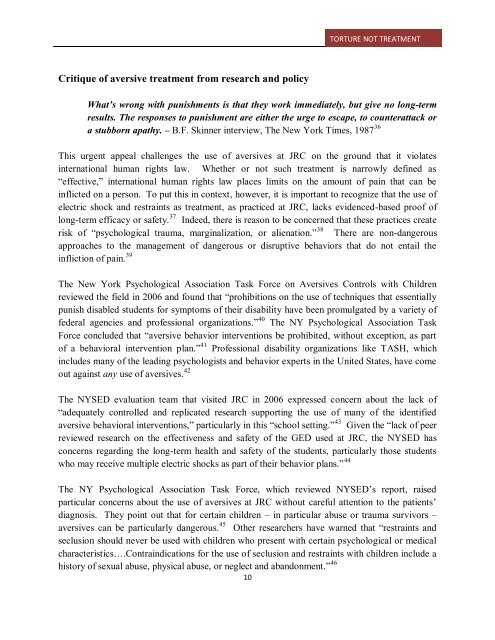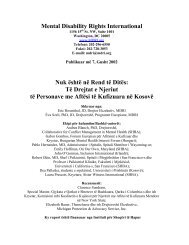Torture not Treatment - Disability Rights International
Torture not Treatment - Disability Rights International
Torture not Treatment - Disability Rights International
Create successful ePaper yourself
Turn your PDF publications into a flip-book with our unique Google optimized e-Paper software.
TORTURE NOT TREATMENT<br />
Critique of aversive treatment from research and policy<br />
What‟s wrong with punishments is that they work immediately, but give no long-term<br />
results. The responses to punishment are either the urge to escape, to counterattack or<br />
a stubborn apathy. – B.F. Skinner interview, The New York Times, 1987 36<br />
This urgent appeal challenges the use of aversives at JRC on the ground that it violates<br />
international human rights law. Whether or <strong>not</strong> such treatment is narrowly defined as<br />
―effective,‖ international human rights law places limits on the amount of pain that can be<br />
inflicted on a person. To put this in context, however, it is important to recognize that the use of<br />
electric shock and restraints as treatment, as practiced at JRC, lacks evidenced-based proof of<br />
long-term efficacy or safety. 37 Indeed, there is reason to be concerned that these practices create<br />
risk of ―psychological trauma, marginalization, or alienation.‖ 38 There are non-dangerous<br />
approaches to the management of dangerous or disruptive behaviors that do <strong>not</strong> entail the<br />
infliction of pain. 39<br />
The New York Psychological Association Task Force on Aversives Controls with Children<br />
reviewed the field in 2006 and found that ―prohibitions on the use of techniques that essentially<br />
punish disabled students for symptoms of their disability have been promulgated by a variety of<br />
federal agencies and professional organizations.‖ 40 The NY Psychological Association Task<br />
Force concluded that ―aversive behavior interventions be prohibited, without exception, as part<br />
of a behavioral intervention plan.‖ 41 Professional disability organizations like TASH, which<br />
includes many of the leading psychologists and behavior experts in the United States, have come<br />
out against any use of aversives. 42<br />
The NYSED evaluation team that visited JRC in 2006 expressed concern about the lack of<br />
―adequately controlled and replicated research supporting the use of many of the identified<br />
aversive behavioral interventions,‖ particularly in this ―school setting.‖ 43 Given the ―lack of peer<br />
reviewed research on the effectiveness and safety of the GED used at JRC, the NYSED has<br />
concerns regarding the long-term health and safety of the students, particularly those students<br />
who may receive multiple electric shocks as part of their behavior plans.‖ 44<br />
The NY Psychological Association Task Force, which reviewed NYSED‘s report, raised<br />
particular concerns about the use of aversives at JRC without careful attention to the patients‘<br />
diagnosis. They point out that for certain children – in particular abuse or trauma survivors –<br />
aversives can be particularly dangerous. 45 Other researchers have warned that ―restraints and<br />
seclusion should never be used with children who present with certain psychological or medical<br />
characteristics….Contraindications for the use of seclusion and restraints with children include a<br />
history of sexual abuse, physical abuse, or neglect and abandonment.‖ 46<br />
10




